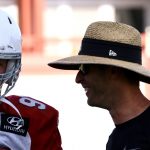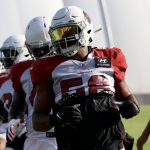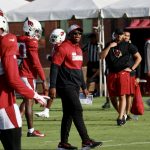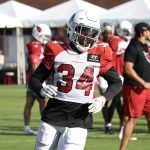Cardinals challenged by Rams’ deeper dimension with Matthew Stafford
Sep 30, 2021, 8:00 PM

Quarterback Matthew Stafford #9 of the Los Angeles Rams warms up before the game against the Indianapolis Colts in the game at Lucas Oil Stadium on September 19, 2021 in Indianapolis, Indiana. (Photo by Michael Hickey/Getty Images)
(Photo by Michael Hickey/Getty Images)
At their core, the Los Angeles Rams’ offense doesn’t look a ton different this season.
Head coach Sean McVay remains, and despite a run of injuries to their backfield, the philosophies are the same. They will make linebackers bite on the run, stretch them horizontally, then hunt explosive plays with play-action.
About that last item: While play-action remains a key ingredient to a McVay offense, it’s no longer so essential for the Rams to be explosive.
That’s because the team traded quarterback Jared Goff to the Detroit Lions and got Matthew Stafford back in return. Not only has that given the Rams a more potent deep passing game — just look at Goff’s very red deep ball chart from last year — it’s made scheming to beat opponents less necessary from a play-calling perspective.
Sometimes, it’s as simple as letting Stafford dice up a defense.
“Some of the throws that he’s able to make and cut loose, a mortal man wouldn’t even attempt, but he can do it,” Cardinals coach Kliff Kingsbury said of Stafford. “He’s always had that gun-slinger mentality where he’s going to take his shots and push the ball downfield, and he can really drive the football. It’s impressive to watch.
“It’s kind of the perfect storm when you get a play caller like McVay and a guy like that who’s played at such a high level like that for so long. He’s tough. He’s a great leader, so they really got it going.”
The Rams were first at the rate of going play-action last season (32%) but now have fallen off to the middle of the pack (25%), per Next Gen Stats.
They’ve gone with empty backfield sets at a league-high rate, where Stafford is 25-of-34 for 345 yards.
Los Angeles’ offensive lines deserves credit for protecting Stafford. They’re allowing sacks on 3.1% of passing possessions (three sacks on 94 attempts).
It’s allowed Stafford to pick apart spread out defenses.
“I think getting pressure is always important,” Arizona defensive coordinator Vance Joseph told reporters on Thursday. “Veteran guy who’s seen every scheme you can give him, getting pressure is key, having tight coverage on their guys. Over the years, playing this team, it’s a great schematic offense. … Pressuring the quarterback is important but it comes down to being focused, detailed.
“If they want to be in one-back sets or empty formations, our rushers have to win, and win quickly. But rushing and coverage go together.”
Arizona will not have the benefit of sitting back in coverage like it did in a Week 3 win against the Jacksonville Jaguars, where inviting forced throws from rookie quarterback Trevor Lawrence was part of the gameplan. Joseph said Stafford and slot man Cooper Kupp, the NFC Offensive Player of the Month, look like they’ve played together for four years.
Kupp has been deployed with the utmost freedom with the ability to adjust routes on the fly — and make up his own variations of route concepts as The Athletic’s Jourdan Rodrigue detailed.
That goes without mentioning the weaponry of the reliable Robert Woods, tight end Tyler Higbee, the still-electric Desean Jackson and the young Van Jefferson, Cardinals assistant Shawn Jefferson’s son.
The Rams’ average intended air yards sits at 8.7 so far, tied for 11th in the NFL this season. Last year, Goff finished fourth-to-last at 6.5 intended air yards.
Stafford has only taken 10 shots downfield, but two of them last week were devastating blows, including a 75-yard shot to Jackson. Against a high-scoring Arizona squad, there’s potential for the playbook to open up.
Not that the Rams have needed a quarterback with such an arm to keep McVay’s record shining against Arizona since he landed in Los Angeles.
“It’s still outside zones, stretch running game. Obviously against play-action pass, it makes it tough against the Rams,” Joseph said.
























